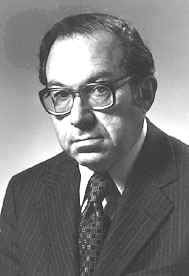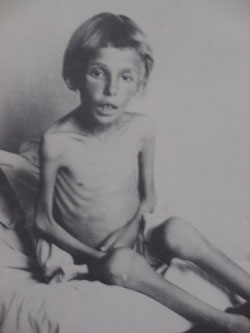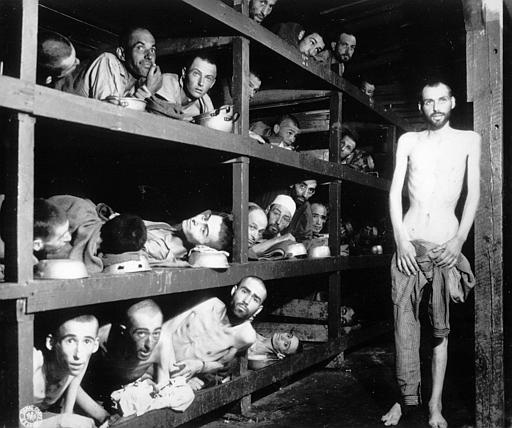

In Memoriam
Here we memorialize persons whose lives and righteousness have served to make the world a better place. They have been chosen for their outstanding contributions to Tikkun Olam and for their roles as leaders, teachers and sources of inspiration to the many who continue the work in their tradition.


Holocaust Scholar Raul Hilberg (1926 – 2007)

"I shall give them an everlasting name." (Isaiah 56:5)
Dr. Raul Hilberg, the world-renowned historian who pioneered and dominated the field of Holocaust scholarship, died on Shabbat, August 4th with his wife Gwen at his side at the Vermont Respite House in Williston, Vermont. His wife reported that he succumbed to a recurrence of lung cancer, which he had contracted although he had never smoked. He is the author of the seminal three-volume Destruction of the European Jews (1961, 1985), a work that took fifteen years to research and write. The landmark study painstakingly documents the existence and operation of Hitler’s "Final Solution," which resulted in the deaths of six million European Jews, one third of the world’s Jewish population.
Hilberg almost shared the fate of the people about whom he wrote. However, in 1938, at the age of twelve, he fled Nazi-occupied Vienna, Austria, emigrating with his parents to Brooklyn, New York. During World War II, he served in the European theater as a member of the U.S. Army.
In 1948, he graduated from Brooklyn College with a Bachelor’s Degree. He followed this with a Master’s Degree in 1950 and a Ph.D. in 1955, both from Columbia University. From 1956 until his retirement in 1991, Hilberg taught at the University of Vermont, where he started the school’s Holocaust Studies Program. In 1992, the school established its Center for Holocaust Studies "to honor Hilberg's teaching and research accomplishments." After his retirement, Hilberg was appointed Professor Emeritus in Political Science at the University of Vermont
Hilberg received many awards in recognition of his contributions to scholarship and for his teachings regarding the Holocaust, including from the German government.In 2005, he was elected as a Fellow to the American Academy of Arts and Sciences.
In addition to The Destruction of the European Jews (1961, revised Ed. 1985), Hilberg was the author of:
For some fascinating and revealing descriptions of Raul Hilberg’s genius and the impact he has had on history and historical scholarship, read these articles.
The "Final Solution"
Li ke any giant of academia, Raul Hilberg had his critics. On one side were those who claimed that his comprehensive and detailed documentation of the technical and bureaucratic aspects of the Nazi death machinery downplayed the role of anti-Semitism and supported those who claimed that people were "just following orders." (Hilberg, however, always claimed that individuals bore responsibility for their actions, a point brought out in his Perpetrators, Victims, Bystanders (1992).) On the other side were the Holocaust "Deniers," who have gone to ridiculous lengths to tar Hilberg’s research and scholarship. (For them, the Nazi’s strategy of leaving nothing overtly incriminating in the records is proof that the Holocaust never took place.)
ke any giant of academia, Raul Hilberg had his critics. On one side were those who claimed that his comprehensive and detailed documentation of the technical and bureaucratic aspects of the Nazi death machinery downplayed the role of anti-Semitism and supported those who claimed that people were "just following orders." (Hilberg, however, always claimed that individuals bore responsibility for their actions, a point brought out in his Perpetrators, Victims, Bystanders (1992).) On the other side were the Holocaust "Deniers," who have gone to ridiculous lengths to tar Hilberg’s research and scholarship. (For them, the Nazi’s strategy of leaving nothing overtly incriminating in the records is proof that the Holocaust never took place.)
Regardless, none of Hilberg’s adversaries have criticized the enormity or quality of his intellect. As one person at a conference commented, "His [Raulberg’s] mind was of a different order." To illustrate this we have made a transcript of the first of several interviews with Dr. Hilberg by Claude Lanzmann, in Shoah, the monumental 1985 film about the Holocaust. (We highly recommend this very moving 9 ½ hour multiple DVD disk film, available to purchase from Amazon, or to rent from Netflix.) Notice how Dr. Hilberg, without notes, succinctly, methodically and eloquently lays out his conclusion that the Nazi’s "Final solution" was the logical end in a long history of persecution of the Jews by the Christian Church and European secular states.
Interview of Dr. Raul Hilberg by Claude Lanzmann (Shoah (1985), Disk 2)
 Hilberg: In all of my work I have never begun by asking the big questions because I was always afraid I would come up with small answers. I have preferred, therefore, to address these things which are minutiae or detail in order that I might then be able to put together, in a gestalt, a picture, which, if not an explanation, is at least a description, a more full description, of what transpired. And in that sense, I look also upon what the bureaucratic destruction process – for this is what it was – as a series of minute steps taken in logical order, and relying above all as much as possible on experience, past experience. And this goes not only, incidentally, for the administrative steps that were taken, but also psychological arguments – even the propaganda. Amazingly little was newly invented until, of course, the moment came when one had to go beyond that which had already been established by precedent, and one had to gas these people or in some sense annihilate them on a large scale. Then, these bureaucrats became inventors. But like all inventors of institutions they did not copyright or patent their achievements, and the prefer obscurity.
Hilberg: In all of my work I have never begun by asking the big questions because I was always afraid I would come up with small answers. I have preferred, therefore, to address these things which are minutiae or detail in order that I might then be able to put together, in a gestalt, a picture, which, if not an explanation, is at least a description, a more full description, of what transpired. And in that sense, I look also upon what the bureaucratic destruction process – for this is what it was – as a series of minute steps taken in logical order, and relying above all as much as possible on experience, past experience. And this goes not only, incidentally, for the administrative steps that were taken, but also psychological arguments – even the propaganda. Amazingly little was newly invented until, of course, the moment came when one had to go beyond that which had already been established by precedent, and one had to gas these people or in some sense annihilate them on a large scale. Then, these bureaucrats became inventors. But like all inventors of institutions they did not copyright or patent their achievements, and the prefer obscurity.
Lanzmann: What did they get from the past – the Nazis?
Hilberg: They got the actual content of measures which they took. For example, the barring of Jews from office, the prohibition of intermarriages, the employment in Jewish homes of female persons under the age of 45, the various marking decrees – especially the Jewish Star – the compulsory ghetto, the voidance of any will executed by a Jew that might work in such a way as to prevent inheritance of his property by someone who was a Christian. Many such measures had been worked out over the course of more than a thousand years by authorities of the Church and by secular governments that followed in those footsteps. And the experience gathered over that time became a reservoir that could be used and which, indeed, was used to an amazing extent.
Lanzmann: You mean that one can compare . . .
Hilberg: One can actually compare a rather large number of German laws and decrees with their counterparts in the past and find complete parallels – even in detail, as if they were a memory, which automatically extended to the period of 1933, 1935 and 1939 and beyond.
Lanzmann: (unintelligible) they did not invent anything?
Hilberg: They invented very little. And they did not invent the portrait of the Jew, which also was taken over love, stock and barrel from writings going back to the 16th century. So even the propaganda, the realm of the imagination and invention, even these – they were remarkably in the footsteps of those who preceeded them, from Martin Luther to the 19th century. And here again they were not inventive. They had to becom inventive with the "final Solution." That was their great invention, and that is what made this entire process different from all others that had preceded that event. And, in this respect, what transpired when the "final Solution" was adopted, or to be more precise, when the bureaucracy moved into it, was a turning point in history.
Even here, I would suggest a logical progression, one which came to fruition in what might be called "closure." Because from the earliest days, from the 4th century, 5th century, 6th century, the missionaries of Christianity had said, in effect, to the Jews, "You may not live among us as Jews." The secular rulers who followed them from the late Middle Ages had then decided "You may not live among us." And the Nazis finally decreed, "You may not live."
Lanzman: And the three steps were – the first one was conversion . . .
Hilberg: Conversion.
Lanzmann: Followed by ghettoization?
Hilberg: Expulsion. Expulsion. And the third was the "territorial solution," which was, of course, the solution carried out within the territories under German command. (pause) Excluding immigration – death. Final Solution. And the "Final Solution, you see is really final because people who are converted can yet be, in secret, Jews; people who are expelled can yet return. But people who are dead will not reappear.
Lanzmann: In a social aspect – the last state – they were really pioneers on the … inventive …?
Hilberg: This was something unprecedented, and this was something new.
"We…shall be compelled to destroy a third of the population in the adjacent lands. We can achieve this by systematic undernourishment which in the end gives a better result than machine guns do. Physically breaking them will be more effective especially among the young." —German Officer Gerd Von Rundstedt, 1942
Photos: Holocaust Museum Houston